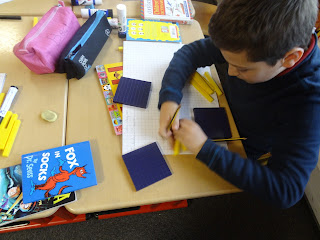We did the lessons I'd planned on area.
Yesterday we went with Graham's Paper Cut.
I think I got this out of sequence: most students found it hard. Half the class looked pretty stumped (at that point I should I think have given them the pdf to help, but I wanted to see what the other ones would do without it!) About a quarter of the class, give or take, got to an answer.
 |
| B did really well - she made a squared paper version of the large sheet, and one of the small sheet, and could see how the big one was twice the little one. I love how she goes off her own way! |
- Although we'd done multiplication as area, this was area as multiplication as areas, a step removed.
- As one of the students said, if the little paper was taken out of the corner it would have been easier to think about. The hole seemed to really puzzle some students.
This is no criticism of the task; just of me getting the order wrong.
I've just started to read Making Thinking Visible, and among lots of really good thinking about thinking, there's a great list of ways of thinking that lead to understanding:
I've just started to read Making Thinking Visible, and among lots of really good thinking about thinking, there's a great list of ways of thinking that lead to understanding:
- Observing Closely and Describing What’s There
- Building Explanations and Interpretations
- Reasoning with Evidence
- Making Connections
- Considering Different Viewpoints and Perspectives
- Capturing the Heart and Forming Conclusions
- Wondering and Asking Questions
We did the first plenty (though actually, as the authors make clear, there's not really an order) but that fourth one, making connections was not strong enough. There weren't enough landmarks, for both the reasons I give above. (Making connections is interesting: there can only be connections if there's enough previous learning; but the previous learning can't be too close in time or content, otherwise it's not really a connection that's being made, just a repetition. The new has to be partly the same, partly different.)
So, as we were two steps ahead, today I went back two steps, and then forward from there.
First of all we drew round books, estimated the area of the front cover, and then measured with hundreds, tens, and smaller Cuisenaire rods. Back to something easy.
Then we went down to look at the teachers study room, for quick orientation. Then we came back and I showed them my video (not shot very well I know!) -
When I asked them what they wondered, it was very obvious (the book measuring was too close!). They wanted to know how many carpet tiles in the whole room. We looked at this:
and people saw very quickly what the other sides must be, so we got down to working the area out. Some just used hundreds and tens:
Some drew:

So, as we were two steps ahead, today I went back two steps, and then forward from there.
First of all we drew round books, estimated the area of the front cover, and then measured with hundreds, tens, and smaller Cuisenaire rods. Back to something easy.
Then we went down to look at the teachers study room, for quick orientation. Then we came back and I showed them my video (not shot very well I know!) -
When I asked them what they wondered, it was very obvious (the book measuring was too close!). They wanted to know how many carpet tiles in the whole room. We looked at this:
and people saw very quickly what the other sides must be, so we got down to working the area out. Some just used hundreds and tens:
Some drew:
And there we had to leave it. I headed off to Amsterdam. There wasn't time for John's great idea of choosing your own L shape. I could still do the staff room. This could be something for next week.
I benefited a lot from the comments in the planning post. Nina's comment has reminded me again that I need to have more knowledge of and be more sensitive to the sequence and level of difficulty of tasks, and although I got it wrong (they would maybe now be ready for Paper Cut), I'm aware that I just need to have a much more detailed appreciation of the order It's especially true when I'm using someone else's lesson; with my own ideas or more familiar lessons I've got more of a feel for sequence.
Joe's stress on seeing the room was spot on, and Graham's idea for a video, though mine is evidently not at all exciting, gave them a really thorough sense that it was area we were looking at by focusing down on tiles (still one student measured round the perimeter with rods).
While I'm away they'll be looking at some triangle areas on real and virtual geoboards.
I also feel that, to make connections with other lessons they'll do, the classes could do with a better understanding of dimensions, of area as two dimension:

And I have another thing for them next week, something I saw when I arrived in Amsterdam Airport, which seems like a next step...
















No comments:
Post a Comment